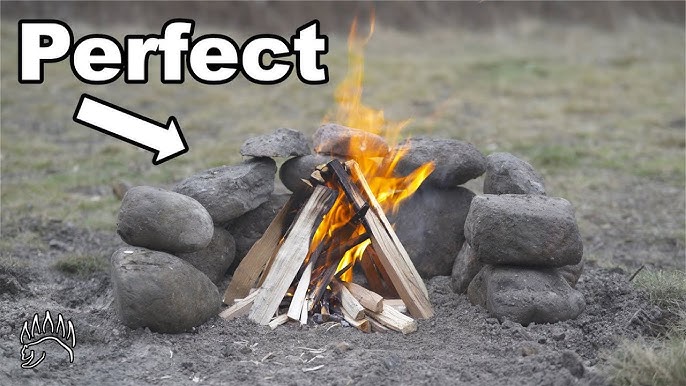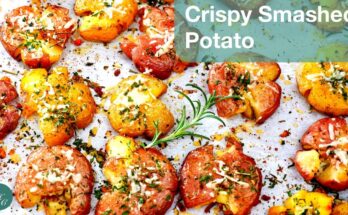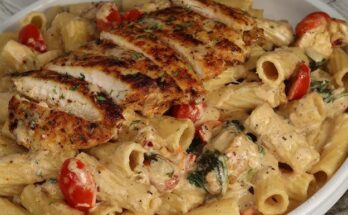Campfire Recipe: Campfire cooking isn’t just about preparing food—it’s about creating an experience. There’s something magical about gathering around a fire under the open sky, hearing the crackle of burning wood, and smelling your food as it roasts slowly over glowing embers. It’s not just a way to cook; it’s a chance to unplug from the modern world and reconnect with nature, friends, and family.
Meals made over a campfire have a rustic, smoky flavor that’s hard to replicate in any kitchen. Whether you’re camping deep in the woods or just cooking in your backyard fire pit, there’s a sense of adventure that comes with every bite. Even the simplest foods—like hot dogs or foil packet meals—taste better when cooked over an open flame.
And let’s be honest: part of the fun is the improvisation. You’re not relying on electric timers or pre-set oven temps. It’s about instinct, patience, and keeping an eye on the fire. This old-school method of cooking brings people together and turns every meal into a shared story.
Essentials You’ll Need for Campfire Cooking
Before you throw on your apron and start tossing food into the flames, you need a few basic tools and ingredients. Preparation is everything, especially when you’re away from home comforts.
Here’s a quick checklist to get you started:
- Campfire grate or grill: Essential for placing pots or pans over the fire.
- Cast iron skillet or Dutch oven: These retain heat well and can handle the direct flame.
- Tongs and heat-resistant gloves: Fire is hot—don’t try to be a hero!
- Aluminum foil: A camper’s best friend. Perfect for packets and easy clean-up.
- Cooler: Keeps your ingredients fresh until you’re ready to cook.
- Wood or charcoal: Make sure you’re using safe, dry firewood or designated campfire fuel.
Once you’ve got these basics, you’re ready to explore a whole world of outdoor culinary options.
Choosing the Right Recipe for a Campfire
Factors to Consider Before Cooking
Not every recipe works well over a campfire. You need something that’s flexible, simple, and doesn’t require exact temperatures or long prep times. When you’re cooking outside, a few things need to be taken into account:
- Time: Stick to meals that cook quickly or can be partially prepped at home.
- Ingredients: Use items that travel well and don’t spoil easily.
- Tools: Choose recipes that don’t require specialty equipment.
- Clean-up: You’ll have limited water, so avoid super messy dishes.
- Group size: Make sure your recipe scales easily to feed everyone.
One of the best ways to ensure your meal turns out well is to do some prep work at home. Dice your veggies, marinate your proteins, and organize everything into labeled bags or containers. That way, when you get to the campfire, all you have to do is cook.
Popular Campfire Recipe Types
Campfire meals fall into a few tried-and-true categories:
- Foil packet meals: These are ideal for beginners. Wrap your protein, veggies, and seasoning in foil, toss them in the coals, and let the fire do the work.
- Skillet dishes: Great for scrambled eggs, sausages, or stir-fry-style meals.
- Grilled items: Think kebabs, corn on the cob, burgers, or steaks.
- One-pot wonders: Use a Dutch oven to create hearty stews, soups, or even chili.
- Campfire desserts: S’mores are the classic, but banana boats and foil-wrapped berry cobblers are also crowd-pleasers.
Stick with simple ingredients and bold flavors. Garlic, herbs, lemon juice, and hot sauce go a long way when cooking outdoors.
Ingredients & Tools Checklist
Basic Ingredients for Campfire Cooking
Depending on your recipe, the ingredients can vary widely. But here are some staples that are versatile, easy to store, and full of flavor:
- Proteins: Chicken, ground beef, sausage, canned beans, or tofu
- Veggies: Bell peppers, onions, zucchini, potatoes, carrots
- Grains: Instant rice, pasta, tortillas, or bread
- Dairy: Hard cheeses, butter, or shelf-stable milk
- Condiments: Salt, pepper, garlic powder, hot sauce, mustard
- Snacks: Crackers, trail mix, marshmallows
It’s all about keeping it simple and packing only what you need. Don’t bring your entire spice rack—just a few key flavors can elevate any campfire dish.
Must-Have Cooking Tools and Equipment
No one wants to find out at the campsite that they forgot the spatula. Here’s a more detailed checklist of tools:
- Heavy-duty foil (non-stick if possible)
- Reusable or compostable plates and utensils
- Fire gloves and pot holders
- Cooking tongs and a spatula
- Grate or tripod stand
- Portable table or surface for prep
- Cooler with ice packs
- Dish soap and sponge
- Trash bags and paper towels
Packing smart means you’ll spend more time enjoying the outdoors and less time struggling with gear.
Step-by-Step Guide to a Classic Campfire Recipe – Foil Packet Chicken and Veggies
Step 1: Preparing the Fire and Cooking Area
First, you’ll need to build a solid cooking fire. Start with dry wood or charcoal and build a fire that burns down to hot, glowing embers. These embers will be your primary heat source for cooking.
If you’re using a fire pit with a grate, position it about 6 inches above the coals. If not, create a flat bed of coals and place your foil packets directly on top. Let the fire burn down for at least 30 minutes before cooking—flames are too hot and uneven for foil packets.
Clear the area around your fire and keep water or a fire extinguisher nearby. Safety comes first, especially when cooking in nature.
Step 2: Gathering and Preparing Ingredients
Now that your fire is ready, it’s time to prep your ingredients. For this foil packet chicken and veggie recipe, you’ll need the following:
Ingredients:
- 2 boneless, skinless chicken breasts (cut into cubes)
- 1 bell pepper (sliced)
- 1 zucchini (sliced)
- 1 small red onion (sliced)
- 2 small potatoes (diced)
- 2 tablespoons olive oil
- 1 teaspoon garlic powder
- 1 teaspoon smoked paprika
- Salt and pepper to taste
- Optional: Fresh rosemary or thyme sprigs
You can easily swap out these ingredients for whatever you have on hand—just keep the cooking times in mind. Root vegetables take longer to cook, so dice them small. Softer veggies like tomatoes or spinach should go in later or be wrapped separately.
Prep Tips:
- Do all your chopping before leaving home.
- Store everything in resealable bags for easy transport.
- If you’re cooking for a group, pre-measure seasoning mixes in small containers or packets.
This not only saves time but also makes for less mess at your campsite.
Step 3: Assembling the Foil Packets
This is where the magic happens. Creating a solid foil packet is key to a well-cooked meal.
Here’s how to do it:
- Tear off a large sheet of heavy-duty foil—about 18 inches long.
- Lay your ingredients in the center: a layer of potatoes first, then chicken and veggies on top.
- Drizzle with olive oil and sprinkle with your spice mix.
- Fold the foil over the food to create a sealed packet. First, bring the long edges together and fold them over twice, then fold in the short edges to create a tight seal.
You can double-wrap the packets to prevent leaks and to provide an extra layer of protection against the flames.
Pro Tip: Label your packets with a permanent marker if you’re making multiple versions (e.g., spicy vs. mild). This way, everyone gets exactly what they want.
Step 4: Cooking Over the Fire
Place your foil packets directly onto the hot embers or on a grill grate above them. Cooking time varies based on how big your packets are and how hot your fire is, but here’s a general guide:
- Cooking Time: 20–25 minutes, flipping halfway through.
- Check Doneness: Carefully open one packet (watch for steam!) and check that the chicken is cooked through and the veggies are tender.
Avoid opening and checking too frequently, as it lets the heat escape. If your fire starts to cool, stoke it gently and add a bit more wood to maintain heat.
Foil packet cooking is wonderfully forgiving. If you’re not sure, give it an extra five minutes—it’s hard to overcook when it’s all sealed up.
Step 5: Serving and Enjoying
Once your packets are cooked, carefully remove them from the fire using tongs or fire gloves. Let them sit for a minute or two to cool slightly before opening.
You can eat right from the foil—no need for extra plates—or serve over rice or bread for a more filling meal. Sprinkle fresh herbs or a squeeze of lemon over the top for an added punch of flavor.
Now sit back, enjoy your rustic feast, and soak up the outdoors. The best part of campfire cooking isn’t just the taste—it’s the memory you’re making with every bite.
Safety Tips for Campfire Cooking
Fire Safety Guidelines
Let’s get serious for a moment—fire is beautiful, but also dangerous if not respected. Always follow these fire safety rules:
- Check regulations: Some parks or forests may ban open fires during dry seasons.
- Keep it controlled: Use a designated fire ring or build a small fire pit.
- Stay close: Never leave a fire unattended, especially when cooking.
- Water is a must: Always have a bucket of water or sand nearby.
- Fully extinguish: Before heading to bed or leaving, douse your fire completely until it’s cold to the touch.
These aren’t just good habits—they’re essential for preserving nature and preventing wildfires.
Food Safety Outdoors
Cooking outside means no refrigerator and limited prep space, so follow these tips to keep your food safe:
- Pack perishables in a cooler with lots of ice.
- Keep raw meat separate from ready-to-eat items.
- Cook meats to proper temperatures (use a meat thermometer if possible).
- Don’t leave food out for more than an hour, especially in warm weather.
Getting sick from poorly stored or undercooked food can ruin an entire trip. Better safe than sorry!
Cleaning Up After Your Campfire Meal
Responsible Waste Disposal
When you’re done enjoying your delicious campfire meal, it’s time to clean up—and this part is just as important as the cooking. Responsible waste disposal is critical when you’re outdoors. Not only does it protect the environment, but it also keeps animals away from your campsite and prevents pollution.
Start by gathering all food scraps, packaging, and used foil. If you’re at a campground, use the designated trash bins. If you’re in the backcountry, pack out everything you packed in. That means bringing a trash bag and making sure you leave no trace behind.
If you have leftover food, don’t bury it or toss it in the woods. Animals can dig it up, which is harmful for them and dangerous for future campers. Instead, store leftovers in sealed containers or dispose of them properly.
Compostable items like fruit peels and eggshells should also be packed out unless you’re at a site that specifically allows composting.
Cleaning and Storing Equipment
Next, focus on your tools and cooking surfaces. Wipe down any utensils, pans, or grills with biodegradable soap and water. If running water isn’t available, use a small bucket or water jug to rinse them.
Here’s a quick step-by-step:
- Scrape off food debris.
- Wash with warm, soapy water (biodegradable only).
- Rinse thoroughly and dry completely.
- Store in a clean container or dry bag to prevent rust or damage.
For foil, if it’s clean and can be reused, fold it and pack it away. Otherwise, crumple it into a ball and dispose of it properly. Don’t burn foil in the fire—it doesn’t decompose and can leave harmful residue.
Keeping your gear clean not only ensures it lasts longer, but it also keeps pests away and your next meal tasting great.
FAQs about Campfire Recipe
What are the best meats for campfire cooking?
Chicken, beef, and sausage are top choices. They cook well in foil packets and on grates. Marinate before the trip for extra flavor and faster cooking.
Can you cook vegetarian meals over a campfire?
Absolutely! Veggies like peppers, mushrooms, and potatoes are perfect for foil packets or skewers. You can also make dishes like grilled tofu, veggie chili, or campfire nachos.
How do I control the heat of a campfire for cooking?
Let your fire burn down to glowing embers for steady, even heat. Avoid cooking over open flames. Adjust cooking distance with a grill grate or by moving coals.
What’s the easiest campfire dessert?
S’mores, of course! But banana boats (bananas with chocolate and marshmallows wrapped in foil) and fire-baked apples are easy and delicious, too.
Can I reuse foil after cooking?
Yes, if it’s not torn or burned. Clean it gently and fold it for reuse. Just avoid using foil that’s had raw meat on it unless it’s thoroughly cleaned.
Conclusion
Campfire cooking is more than just making food—it’s an experience filled with flavor, fun, and a touch of adventure. From the satisfying sizzle of ingredients wrapped in foil to the joy of sharing a smoky, fire-roasted meal under the stars, it’s one of the best parts of any camping trip.
Whether you’re a seasoned camper or a first-timer, the key to a great campfire recipe lies in preparation, simplicity, and embracing the natural rhythm of outdoor cooking. Foil packet meals like chicken and veggies are easy, customizable, and foolproof for anyone cooking over open flames.
As you plan your next trip into the wild, don’t forget your basic gear, follow safety protocols, and clean up like a pro. Your taste buds—and nature—will thank you for it.
So gather your firewood, spark those flames, and get cooking. The great outdoors is your kitchen now.



